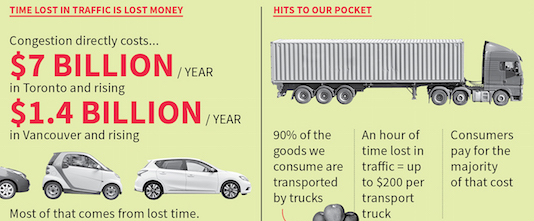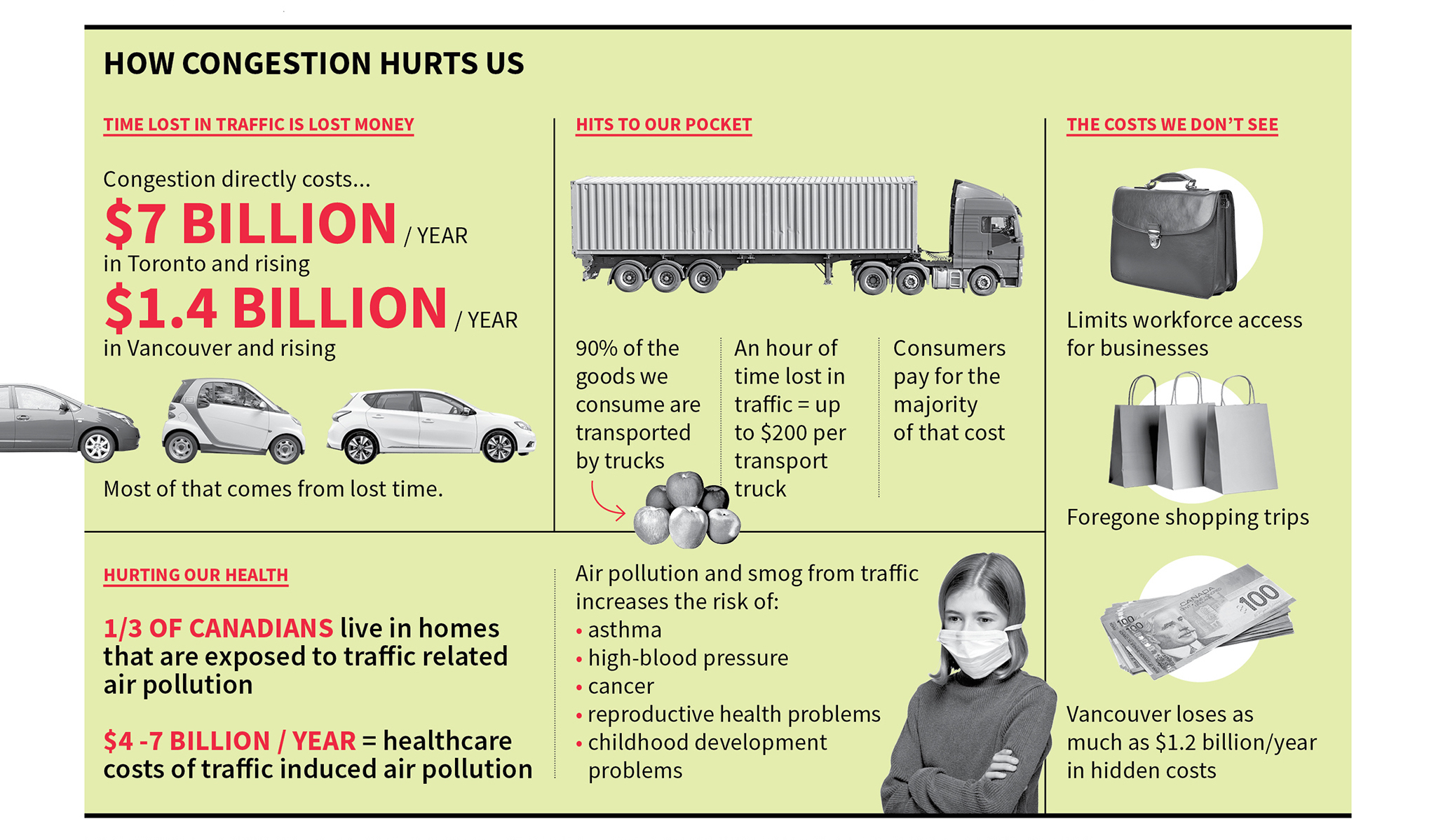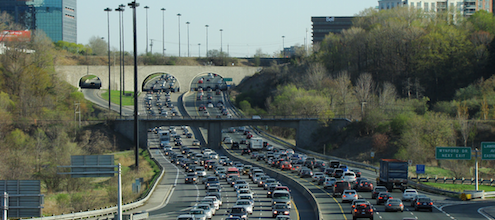
TLDR: The low-down on our latest report about congestion pricing

The Ecofiscal Commission’s latest report makes the case for implementing congestion pricing pilot projects in Canadian cities. In case you don’t have time to read the report, here are the findings in a nutshell.
The new report, We Can’t Get There from Here: Why Pricing Traffic Congestion Is Critical to Beating It, describes why congestion pricing makes good economic sense, considers case studies from around the world, and discusses policy options that could help major Canadian cities reduce gridlock. The principal conclusion: since these policies are largely new to Canadians, we should start with small-scale trials.
Traffic congestion is increasingly costly for Canadians
Here’s the thing: traffic congestion is costly. It leads to lost time and frustration for commuters. It adds costs to the transport of goods, leading to higher prices. It exacerbates local air pollution and the health costs associated with them. And as our cities grow, congestion is getting worse.
Congestion pricing is the crucial missing element for reducing congestion
So what can we do about it? On its own, expanding transportation infrastructure usually fails to reduce traffic in the long run. In many cases, more road capacity makes driving more appealing. Over time, commuters respond by driving more, and congestion returns.
Adding congestion pricing tools—such as high occupancy toll lanes and time-variable bridge tolls—to the policy mix changes the game. It creates incentives for drivers to consider other modes of transit or travel at different times. Road space is scarce, and congestion pricing changes incentives to reflect this scarcity. As a result, it increases the effectiveness of new infrastructure and public transit expansion. Congestion pricing improves mobility.
Congestion pricing works in reducing traffic
Experience in other cities with congestion pricing illustrates how these policies can work in practice and generates insights that help inform the design of effective policy. Our report includes five case studies that illustrate how different congestion pricing tools can reduce traffic congestion:
- Single entity pricing—the 407 Express Toll Route: The first open-access, all-electronic toll highway in the world, the 407 in Ontario, has shown that congestion pricing can be effective in Canada, and that technology is no longer a barrier to electronic charging.
- High Occupant Toll (HOT) lanes—the MnPASS System: The Minnesota Department of Transportation introduced one of the first dynamically priced HOT lanes in 2005—allowing single drivers to access existing HOV lanes for a fee—showing how HOT lanes can improve vehicle flow on both HOT and unpriced lanes.
- Zone-Based Pricing—Stockholm’s congestion charge: In 2006, Stockholm brought in a time-varying charge to drive in the downtown core; the policy was effective in reducing congestion and air pollution, and despite initial opposition, residents voted in favour of keeping the policy in place.
- Distance-Travelled Charges—Oregon’s pilot projects: Oregon has experimented with per-mile vehicle charges to replace a gas tax; when prices were higher pricing during rush hour, traffic was reduced.
- Parking Pricing—San Francisco’s parking pricing pilot project: Circling to find parking is a big part of downtown congestion. San Francisco demonstrated that adjusting parking rates in response to demand can help to reduce congestion. In 2013, Calgary started using a similar approach to parking pricing.
Each city is unique—congestion pricing policy must reflect local characteristics
Details of policy design matter, and congestion-pricing policies can be tailored to the unique characteristics and concerns of each city; the best approach for one city may differ from the best approach for another. In particular, the design of congestion pricing policies must reflect cities’ geography, infrastructure, governance, and culture.
The report proposes congestion pricing options for Canada’s four largest cities. They are not firm recommendations—rather, they are intended as policy springboards to kick-start more detailed policy conversations in each city:
- Metro Vancouver: Multiple hubs of activity, and relatively constrained geography make variable pricing on each of the region’s bridges and tunnels that cross waterways a practical way to price access to key routes to reduce regional congestion.
- Calgary: Low density and localized congestion problems make HOT lanes a practical option for reducing congestion in the city.
- Greater Toronto Area: Multiple hubs of activity, and relatively unconstrained geography make converting high-occupancy vehicle (HOV) lanes to HOT lanes (or building new HOT-lane capacity) on the provincially owned 400-series of highways a practical approach for reducing congestion in the area.
- Greater Montreal: The natural cordon formed by the Island of Montreal provides a practical opportunity to implement variable pricing on the full array of surrounding bridges and tunnel, harmonizing tolls and reducing congestion throughout the area.
Let’s test congestion pricing in Canadian cities
Canadians don’t have much experience with these policies, and it’s understandable that they would want to see it first-hand before making up their minds. To get started, Ecofiscal recommends that Canadian cities should test congestion pricing policies on a trial basis to show how they can cut traffic. Provinces should help—there is often shared jurisdiction over municipalities’ roads, so cooperation with the province is key. And the federal government should participate too, by helping to fund pilot projects—policy lessons from one city can be informative for others, and reducing the cost of congestion on commercial transport can reduce the costs of goods and services for all Canadians.
Traffic is more than a pet-peeve—it is imposing real costs on Canadians. As cities grow and congestion problems build, we desperately need smarter policy; and pricing congestion is the missing piece of our urban mobility puzzle. See the report for more details.
Read the Report: We Can't Get There from HereWatch our Video Series: Stuck in Traffic with an Economist






Comments are closed.